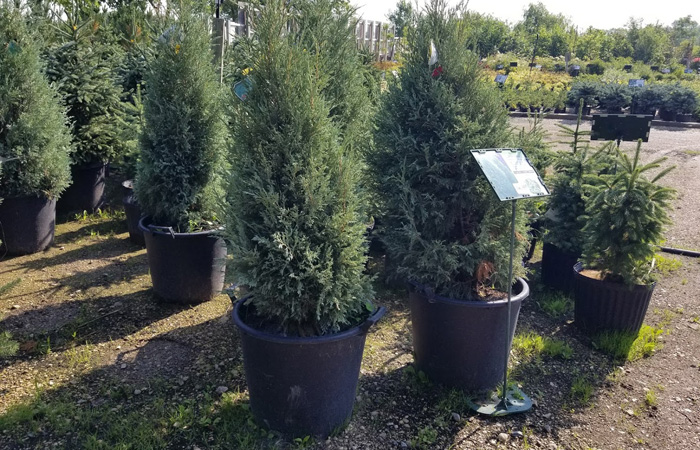I have had many customers come to me at our nursery asking for “the evergreen tree that stays little.” There are options like that, but none that will thrive in our Manitoba climate unfortunately. We are working on that looking for better options. The best option we have at this time is called Medora Juniper. Let me tell you about it.
The Medora Juniper is a selection of Rocky Mountain juniper, which is native to the Canadian west coast and the Rocky Mountains (naturally). But the Medora Juniper specifically was selected from a family of Rocky Mountain Junipers growing in North Dakota. I suspect that the juniper was named after the town Medora in western North Dakota, but my research could neither deny nor confirm this. Many of the Junipers in the area are naturally upright but Medora was extra dense. It has a tight upright form, naturally gaining a teardrop form with very little to no pruning required.
As an evergreen it is on the slower growing side. In a good summer, with its needs met, it could grow some six to eight inches throughout the growing season. It grows to about 15 feet in 20 years. This means it will stay a small manageable size for at least 10 years. Like all trees they never truly stop growing. Once they reach the size you like trimming off a few inches every spring will keep its size contained and its form even more compact.
The largest Medora Juniper I have ever seen was close to 40 feet tall and was nearing 80 years old. It is planted on the campus of North Dakota State University, and it is the original Medora Juniper. It was originally selected by Harry Graves and has been a wide spread success ever since.
Medora Juniper has a zone two cold tolerance making it a worthy option for the prairies. Like all evergreens it can get sunburn overwinter from the south sun, but junipers are more drought tolerant and sunburn resistant that Cedars. This gives them a one up over cedars for sun exposed areas.
It is still highly beneficial to set up burlap in the fall to provide overwinter protection, especially in the first few winters. The north winds are typically not a threat to the Medora juniper but if you want to set up burlap on all sides there is no harm done.
Another benefit of the Juniper over the Cedar is that deer and rabbits are much less likely to eat Juniper. Cedar is a classic favourite of wildlife and a small fence of stucco wire is highly recommend for protection. Juniper is far lower on the menu but desperate animals will eat pretty much anything. Again, setting up the stucco wire is not overkill. Better to be safe than sorry.
Cedars prefer a damp shady location while the Juniper prefers a sunny well drain spot. They are much more drought tolerant and generally easier to please than Cedars. Both are great plants for the yard, but for opposite locations. Make sure to consider the area you are wanting to plant in before deciding which one to go with.
Another thing that sets the Medora Juniper aside from Cedars is the colour of its foliage. Cedars often have a rich green colour whereas this Juniper is a frosty blue making it a great option for colour contrast in the yard.
An interesting fact about the Medora Juniper is that it is male, and therefore sterile. Most junipers will produce some berries that wildlife will enjoy or can even be used in baking. But Medora makes no fruit and no mess.




